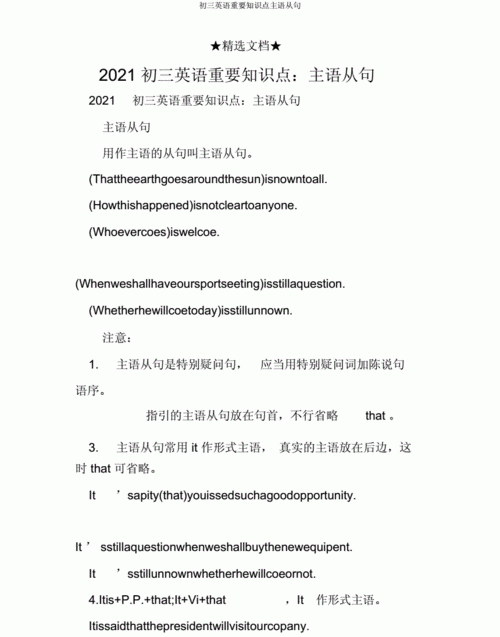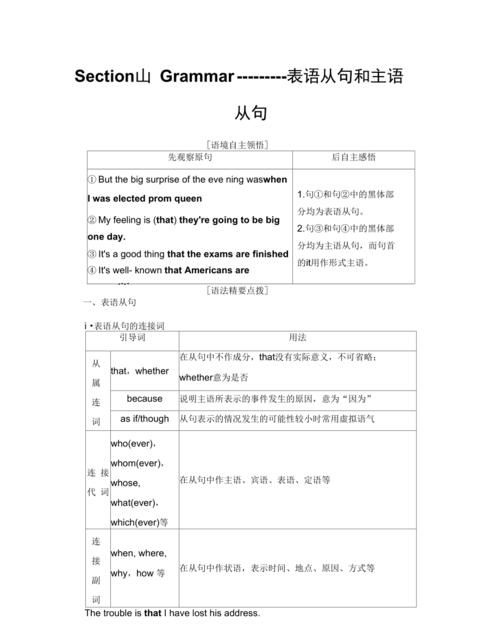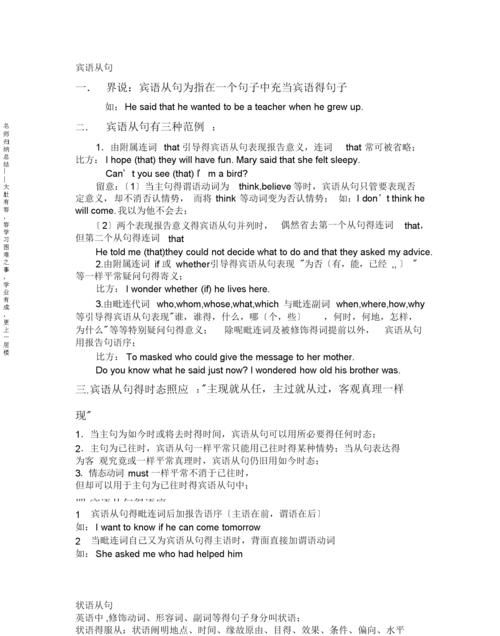本文目录
六年级英语语法知识点归纳
主语表明这句话说的是谁和什么,主语主要由名词、代词或相当于名词的单词,短语或从句充当。下面是我整理的关于主语的英语语法知识点,希望对你有所帮助。
一、名词作主语
Davidarrivedlastnight.
大卫昨晚到达。
Pridegoesbeforeafall.
骄必败。
二、代词作主语
Whoisspeaking,please?
(在电话中)请问您是谁?
That'sOK.
这没问题。
三、数词作主语
Twowillbeenough.
两个就够了。
Two-thirdsoftheworkersarewomen.
三分之二的`工人是女工。
四、ing形式作主语
Skatingisgoodexercise.
溜冰是很好的运动。
Lookingupallthenewwordsinthedictionarytookhimalotoftime.
从字典里查所有的生词花费了他许多时间。
五、不定式作主语
Totranslatethisidealintorealityneedshardwork.
把理想转变成现实需要辛勤的劳动。
六、名词化的形容词作主语
Theblindandthelamearewellcaredforinourcountry.
在我们国家,盲人和肢残人受到很好的照顾。
Theunemployedusuallyleadahardlife.
失业的人生活一般很困难。
七、短语作主语
Howtodowellisanimportantquestion.
如何把这件事做好是一个重要问题。
Earlytobedandearlytorisemakesamanhealthy.
早睡早起身体好。
八、从句作主语
Whathashappenedprovesthatourpolicyisright.
发生的一切证明我们的政策是对的。
Whetherwe'llgodependsontheweather.
我们是否去要看天气。
拓展知识:语法小知识:主语从句概念解析
一. 概念:
在句子中担当主语的从句就叫做主语从句,通常放在主句谓语动词之前或由形式主语it代替,而本身放在句子末尾。
主语从句使用陈述语序,其通常结构为“引导词 + 主语 + 谓语 + 其他成分", 但当连接代词同时充当从句主语时,其结构为“连接代词 + 谓语 + 其他成分”。
二. 引导词:
1. that引导
eg. That you are coming to London is the best news I have heard this long time.
2. whether引导
eg. Whether they would come to conference was a question.
3. 连接代词引导:who,whom, whose, what, which, whoever, whomever, whichever, whatever
eg. Whoever is top from wins the game when two matched players meet.
4. 连接副词引导:therefore, besides, otherwise, however, moreover, still, thus, meanwhile
eg. How this happended is not clear to anyone.
5. 关系代词型what引导
eg. What shoked me was that she never wash her own clothes.
三. 形式主语it:
1. 对关系代词型what引导的主语从句,可以使用形式主语。
eg. It is clear enough what he meant.
2. 如果句子是疑问句,则必须用带形式主语it的结构.
eg. Is it true that all of us need to to conference?

初中英语语法大全知识点总结
初中英语语法知识点总结1
名词的所有格:表所有关系
两种表示法:’s和of
1)用and连接两个并列的单数名词表示共有关系时,只在最后一个名词后加’s;表示分别拥有各自的物品时,两个名词都要加’s.
eg: Mary and her sister’s bedroom 玛丽和她妹妹的房间 Tom’s and Mary’s bags 汤姆的和玛丽的包
2)以s结尾的名词,在s后加’, 不以s结尾的加’s
eg: Teachers’ Day Children’s Day
3)双重所有格,形式:of+名词所有格;of+名词性物主代词
eg:He is a friend of my brother’s. Is she a daughter of yours ?
辨析: a picture of her mother’s 她妈妈的一张照片(强调照片是她妈妈的,但照片上的人不一定是她妈妈)
a picture of her mother 她妈妈的照片(强调照片上的人是她妈妈)
4)表示店铺、医院、诊所、住宅等名称时,常用名词后加上’s代表全称 at the doctor’s 在医院的候诊室
5)在some, any, every和one, boby结合起来的复合名词后加’s
someone’s book 某人的书, somebody else’s pencil 其他人的铅笔
6)表示时间,距离,国家,城市等无生命的名词,也可以在词尾加’s或’构成所有格。
意:名词+of+名词名词是有生命的,我们就用’s结构来表示所有关系。如果名词所表示的事物是无生命的,我们就要用名词+of+名词的结构来表示所有关系.如: the legs of the desk,the door of the room
但在表示名词所有格时,’s结构也常可转换成of结构。有些表示时间,距离、国家、城市等无生命的东西的名词,也可以加’s来构成所有格.如: ten minutes' walk,today's newspaper
初中英语语法知识点总结2
1、be late for. 迟到
Don’t be late for school.不要上学迟到。
2、play + 球类名词:打/踢球(注意:球类运动不用冠词)
play +the+ 乐器(西洋)
playping-pong/basketball/volleyball/tennis/soccer
3、sound
1)连系动词,“听起来”,后接形容词作表语。
That story sounds very interesting.那故事听起来很有趣。
2)名词“声音”(泛指自然界中的各种声音)。
The sound is too loud.声音太大了。
4、every day 每天
She plays sports every day. 她每天都做运动。
everyday日常的 everyday English 日常英语
5、after class 下课后 after school 放学后
6、辨析interesting与interested
1) interesting可作表语,指某人/事/物本身有趣;也可作定语修饰人或物
① The book is interesting.这书很有趣。 (作表语)
②I have an interestingbook.我有本有趣的书。(作定语)
2) interested用于be/get/become interested in(对感兴趣)这一结构中。
He is interested inplaying football.他对踢足球感兴趣。
7、like 喜欢
1)like sb. / sth.喜欢某人/某物
2) like to do sth.喜欢/想要做某事(表一次性或特指的某一具体的动作)
3) like doing sth喜欢做某事(表习惯性的动作或爱好)
①我喜欢每天打篮球。I like playing basketballevery day.
②今天很冷,我喜欢呆在家里。Todayis cold, I like to stay at home.
初中英语语法知识点总结3
一、陈述句
陈述句是陈述一个事实或者说话人的看法的,陈述句分为肯定句和否定句。陈述句句末用句号,朗读时用降调。
1、肯定句的基本结构为:主+谓 He went to London to pass his holiday.
2、否定句的表达方式
(1)主语+be+not+表语 He is not a teacher.
(2)主语+助动词/情态动词+not+谓语动词+其他 I don't think you are right. He hasn't yet paid the money. (他尚未付钱。)
(3)使用“not”以外的否定词:
(a)副词:never, seldom, hardly, little, neither等。She seldom comes to see me. (她不常来看我。)
(b)形容词:no, few, little等 He has few friends in Hong Kong. (他在香港几乎没有朋友。)
(c)代词:nothing, nobody, none等。I found nobody about computer. (在那栋房子里我没看到任何人。)
二、疑问句
疑问句的主要交际功能是提出问题,询问情况。分为一般疑问句、选择疑问句、特殊疑问句和反意疑问句。
1、一般疑问句通常用来询问一件事情是否属实。答句通常是“yes或no”。 句型一:Be +主语+ …?Are these books on the desk?这些书在桌子上吗?
句型二:Do / Does / Did + 主语 +谓语+…?Do you like English?你喜欢英语吗? 句型三:情态动词 + 主语 + 谓语 +…?
Must I finish my homework now?我必须现在完成我的家庭作业吗?
句型四:Have / Has + 主语 + 过去分词+…?
Have you heard from him? 你收到他的来信吗?
另外,还有以be动词、助动词或情态动词的否定缩写形式开头的一般疑问句,这种句子一般表示请求、惊讶和对事物的看法等,回答时所用的yes和no表达的意思和汉语的习惯不同。例如:——Isn't he tall?难道他不高吗?
—— Yes, he is.不,他很高。
2、特殊疑问句以疑问词开头,对句中某一成分提问的句子叫特殊疑问句。常用的疑问词有:what 、who 、whose 、which、 when、 where、 how 、why等。例如: who is singing in the room?
what class are you in﹖
初中英语语法知识点总结4
初中英语语法常用
1)在代词what, which, who, none, some, any, more, most,all等词的单复数由其指代的词的单复数决定。
All is right. (一切顺利。)
All are present. (所有人都到齐了。)
2)集体名词作主语时,谓语的数要根据主语的意思来决定。如family, audience, crew, crowd, class, company,committee等词后用复数形式时,意为这个集体中的各个成员,用单数时表示该个集体。
His family isn't very large.他家不是一个大家庭。
His family are music lovers.他的家人都是音乐爱好者。
但集合名词people, police, cattle, poultry等在任何情况下都用复数形式。
Are there any police around?
3)有些名词,如variety, number, population, proportion, majority等有时看作单数,有时看作复数。
A number of +名词复数+复数动词。
The number of +名词复数+单数动词。
A number of books have lent out.
The majority of the students like English.
初中英语语法口诀
一、冠词基本用法
【速记口诀】
名词是秃子,常要戴帽子,
可数名词单,须用a或an,
辅音前用a,an在元音前,
若为特指时,则须用定冠,
复数不可数,泛指the不见,
碰到代词时,冠词均不现。
【妙语诠释】冠词是中考必考的语法知识之一,也是中考考查的主要对象。以上口诀包括的意思有:
①名词在一般情况下不单用,常常要和冠词连用;
②表示不确指的可数名词单数前要用不定冠词a或an,确指时要用定冠词the;
③如复数名词表示泛指,名词前有this,these,my,some等时就不用冠词。
二、名词单数变复数规则
【速记口诀】
单数变复数,规则要记住,
一般加s,特殊有几处:
/s/结尾,es不离后,
末尾字母o,大多加s,
两人有两菜,es不离口,
词尾f、fe,s前有v和e;
没有规则词,必须单独记。
【妙语诠释】
①大部分单数可数名词变为复数要加s,但如果单词以/t/、/y/、/s/发音结尾(也就是单词如果以ch,sh,s,x等结尾),则一般加es;
②以o结尾的单词除了两人(negro,hero)两菜(tomato,potato)加es外,其余一般加s;
③以f或fe结尾的单词一般是把f,fe变为ve再加s;
④英语中还有些单词没有规则,需要特殊记忆,如child—children,mouse—mice,deer—deer,sheep—sheep,Chinese—Chinese,ox—oxen,man—men,woman—women,foot—feet,tooth—teeth。
初中英语语法:句型转换
Ⅰ.题型介绍
所谓“句型转换”就是先给一个完整的句子A,再根据括号内的要求(有时没有明确,须自己观察),在第二个句子B的空白处填上适当的词来完成的句型转换。
Ⅱ.题型分类
从形式上看,有如下几种形式:
①某一词或词组的转换;
②词组与句子的转换;
③同义句型的转换;
④为纠正常犯语言错误而设计的题目。
从内容上看,此题型涉及的面较广,主要有:
①句子功能方面的转换。包括陈述句(肯定与否定)、四种题疑问句、祈使句、感叹句的转换;
②句子结构方面的转换。即简单句、复合句、并列句之间的转换;
③语态的转换。即主动语态与被动语态之间的转换;④常用句型与词汇手段的转换。
Ⅲ.具体分类如下
一、陈述句与疑问句、祈使句、感叹句间的转换
1、陈述句中肯定句变为否定句,大部分是用not来改变谓语结构,但也有借用否定意义的词,如nothing, nobody, none, neither,little, few, never, hardly等,例如::
A:Tom does well in maths.
B:Tom doesn't do in maths.
A:He has much to do.
B:He has nothing to do.
A:All of my classmates like art.
B:None of my classmates likes art.
2、改为疑问句。根据上下句的结构和词的减少,来判断变为哪一种形式的疑问句。例如:
A:My brother often has breakfast at school.
B:Does your brother often have breakfast at school?
A:Tom's already weak in English.
B:Tom's already weak in English, isn't he ?
A:The red light changes every two minutes.
B:How often does the red light change?
3、改为感叹句。根据所给的句子结构和单词的词性,来确定使用哪一种感叹句的形式,例如:
A:This is an interesting book.
B:What an interesting book this is!或How interesting this book is!
初中英语语法知识点总结5
表示说的话不是事实,或者是不可能发生的情况,而是一种愿望、建议或与事实相反的假设等。一般常用于正式的书面语中。
1、虚拟语气的构成
如:与现在事实相反
If I had more time, I should study German.(fact:I have no more time, so I shall not study German. )
If she were not so busy, she would attend the meeting this afternoon.(fact:she is very busy, so she will not attend the meeting this afternoon.)
If they didn’t take physical exercises every day, they wouldn’t be so healthy.(fact: they take physical exercises every day, so they are very healthy.)
与过去事实相反:
I would have checked my paper again if I had had more time at yesterday’s examination.(fact:I had no more time at yesterday’s exam, so I didn’t check my paper again)
You would have already recovered from his illness if he had seen the doctor in good time.(fact: He didn’t see the doctor in good time ,so he hasn’t recovered from his illness )
与将来事实相反:
If it rains tomorrow, our picnic will be put off.(The weather has been changeable these days.)
If it rained tomorrow, our picnic would be put off.( The weather has beenvery good these days.)
If it should rain tomorrow, our picnic would be put off.(That would be out of our expectation.)
If it were to rain tomorrow, our picnic would be put off. (条件从句谓语动词用were to +动词原形,表示下雨的可能性极小。Were to rain和should rain都表示“出乎意料之外”,但were to加强表示“当初没想到以后的事”)
注:
(1)如果条件从句谓语动词包含有were或had, should, could有时可将if省去,但要倒装。如:
Had you (If you had) invited us, we would have come to your party.
(2)混合时间条件句的用法:
有时条件从句的动作和主句动作发生的时间不一致。这时动词的形式,应根据它所要表达的具体时间来决定用什么形式。
1) If she hadn’t trained so hard, she wouldn’t be run so fast.(从句叙述过去,主句叙述现在。)
(fact: she has trained very hard, so she would able to run fast.)
2)You would speak English well enough if you had practised reading and speaking it every day.(主句叙述现在,从句叙述过去)
(fact: You didn’t practice (hasn’t practiced ) reading and speaking it every day, so you can’t speak English well enough.)
(3)在其他状语从句中的用法
主要用于由as if (as though)引导的比较状语从句,从句中谓语动词一般用“动词的过去式(be变were )或had +过去分词。”如:
She looked as if she were ill.(实际上她没有病,在这里用虚拟语气补语比喻她精神不佳)
Xiao Liu speaks English so well as if he had studied in England.(这里用虚拟语气表现他的英语说得好)
2、虚拟语气在各种从句的应用
(1)在主语从句中用来表示惊奇、惋惜、理应如此等,其谓语形式是"should(可省) +动词原形",常用于以下三种句型中。
句型一:It is necessary (important, natural, strange, etc) that…
句型二:It is a pity (a shame, no wonder, etc) that…
句型三:It is suggested (requested, proposed, desired, etc) that…
如:It is strange that he (should) have done that.
It is a pity that he (should) be so careless.
It is requested that we (should) be so careless.
(2)在宾语从句中用于suggest, propose, move, insist, desire, demand, request, order, command等动词后的宾语从句中,表间接的命令和建议。其谓语形式是"(should)+动词原形"。如:
I suggest that we (should) go swimming.
(3)在表语从句中,表示间接的命令,要求、请求、建议、决定等,主句中的主语通常是suggestion, proposal, request, orders, idea等。从句谓语形式是"(should)+动词原形"。如:
His suggestion is that we (should) leave at once.
(4)在同位语从句中,谓语形式是"(should)+动词原形"。如:
We received order that the work be done at once.
(5)在It is time that…句型中,其谓语动词形式是"动词的过去式"或"should +动词原形",should不可省。如:
It's time (that) we went ( should go) to school.
初中英语语法知识点总结6
在习惯上只用作定语的形容词
这里说的定语指的是位于名词前作定语(即前置定语),而不是位于名词后作定语(即不用作后置定语),如main 是定语形容词,可以说mainthings,但不能说something main,因为后置定语从本质上说相当于表语,即something main 从本质上说相当于somethingthat is main。下面是几类典型的定语形容词:
一、表示相对关系的形容词
former 以前的,从前的 latter 后期的,后半的
inner 内部的,里面的 outer 外部的,外面的
upper 上部的,上游的 lower 下部的,下游的
elder 年岁较大的 eldest 最年长的
indoor 室内的,屋内的 outdoor 室外的,屋外的
inside 里面的,内侧的 outside 外面的,外侧的
upstairs 楼上的 downstairs 楼下的
【注】inside, outside, downstairs, upstairs等既可用作形容词也可用作副词。用于形容词时,只用于名词前作定语;若用作副词,则可用作表语(或名词后作定语)。
二、表示强调意义的形容词
mere 仅仅的 very 极端的
outright 完全的 thorough 十足的
plain 完全的 complete 彻底的
pure 完全的 perfect 全然的
【注】若用于其他意义,有的可用作表语,如plain表示“明白的”、“普通的”等均可用作表语;perfect表示“完美的`”、“完备的”、“准确的”等,也可用作表语。
三、表示度量的复合形容词
three-year-old 3岁大的 120-page 120页的
five-year 5年的
若用作表语或后置定语,则不用连字符:
She has a five-year-old son. 她有一个5岁的儿子。
Her son is five years old. 她的儿子五岁。
She has a son five years old. 她有一个5岁的孩子。
八种宾语从句不省略that
引导宾语从句的that在下列情况下一般不省略:
1. 宾语从句前有插入语。如:
We hope, on the contrary, that he will stay at home with us.恰恰相反,我们希望他和我们呆在家里。
2. 有间接宾语时。如:
He told me that he was leaving for Japan. 他告诉我他要去日本。
3. that在与之并列的另一个宾语从句之后。如:
He said (that) the book was very interesting and that(不省略) all the childrenlike to read it.他说那本书很有趣,所有小孩都喜欢读。
4. 在“it(形式宾语)+补语”之后时。如:
I think it necessary that he should stay here. 我们认为他有必要留在这里。
5. that从句单独回答问题时。如:
—What did he hear? 他听说了什么事?
—That Kate had passed the exam. (他听说)凯特考试及格了。
6. 在except等介词后。如:
He has no special fault except that he smokes toomuch.他除了抽烟太多之外,没有什么特别的毛病。
7. 位于句首时。如:
That our team will win, I believe. 我相信我们队会赢。
8. 在较为正式或不常用的动词(如reply, object)后。如:
He replied that he disagreed. 他回答说他不同意。
if与whether的区别
1. 引导主语从句并在句首时不用if。如:
Whether we go there is not decided. 我们是否去那里还没决定。
2. 引导表语从句时不用if。如:
The question is whether we can get there on time. 问题是我们能否按时到达那里。
3. 引导同位语从句时不用if。如:
He asked me the question whether the work was worth doing.他问我这个问题,那项工作是否值得做。
4. 在介词后引导宾语从句不用if。如:
I’m thinking about whether we’ll have a meeting. 我在考虑我们是否要开个会。
5. 直接与not连用时不用if。如:
I don’t know whether or not you will go. 我不知道你是否去。
6. 宾语从句置于句首时不用if。如:
Whether you have met George before, I can’t remember. 我不记得你以前是否见过乔治。
7. 在discuss等之后时不用if。如:
We’re discussing whether we’ll go on a picnic. 我们在讨论是否要去野餐。
8. 当用if会引起歧义时不用if。如:
Please let me know whether you are busy.请告诉我你是否忙。(若用if,还可理解为“如果你很忙,你就告诉我。”
初中英语语法知识点总结7
at the end of用法
对于at the end of的用法,同学们需要掌握下面的内容。
at the end of
at the end of +时间点或地点,“在…的尽头,在…的末尾”
They will have a sports meeting at the end of March. (时间)
He put some books at the end of the bed. (地点)
动词的种类
动词是表示动作或状态的词,按其词义和在句子中的作用可分为行为动词,连系动词,助动词和情态动词。
1.行为动词
行为动词可分为及物动词 (vt)和不及物动词(vi),及物动词表示动作或状态,有完整的词义,能单独作谓语,后跟宾语;不及物动词表示动作或状态,有完整的词义,能单独作谓语,但后面不能直接跟宾语,如要带宾语则与介词或副词构成短语。
如:
More and more people study English.(vt)
The students are listening to the teacher carefully.(vi)
2.连系动词
连系动词本身有一定的词义,但不能独立作谓语,必须与表语一起构成谓语。常用的连系动词有 be, get, turn, become, look, feel, grow, seem, sound, taste, smell等。
如:
Our country is becoming stronger and stronger.
It feels damp.
3.助动词
助动词本身无词义,不能单独作谓语,只能和主要动词一起构成谓语动词,表示否定,疑问及动词的时态、语态、人称和数等语法特征,助动词有 be,do,have,shall,will等。
如:
How do you usually come to school?
The children are playing yo-yo now.
4.情态动词
情态动词本身有一定的意义,但不能独立作谓语,只能和主要动词原形一起构成谓语,表示说话人的语气和情态。情态动词没有人称和数的变化。情态动词有 can (could),may(might),must, need, ought to, dare等。
如:
Can I help you?
- Must we go now? -No, you needn't .
a. can与be able to的用法有所区别。can只用于一般现在时和过去时,指本身有能力的"能";be able to用于各种时态均可,指须经过努力而"能"。
b. must与have/has to的用法。must表示说话人主观认为"必须",只用于一般现在时和一般将来时;have/has to表示客观需要,意为"不得不",它可用于各种时态。
c.need和dare既可作情态动词也可作行为动词。
以上对动词的种类知识的内容讲解学习,相信同学们已经能很好的掌握了吧,希望同学们在考试中取得很好的成绩。
初中英语语法知识点总结8
should的用法:
should用来提出建议和忠告,后边加动词原形,否定句直接在should后边加not.
例如:I think you should eat less junk food.
我认为你应该少吃垃圾食品。
She drives a lot and she seldom walks. So I think she should walk a lot.
她经常开车,很少走路。所以我认为她应该多走路。
Students shouldn’t spend too much time playing computer games.
学生们不应当花太多的时间玩计算机游戏。
学习向别人提建议的几种句式:
(1)I think you should…
(2)Well, you could…
(3)Maybe you should …
(4)Why don’t you…?
(5)What about doing sth.?
(6)You’d better do sth.

连接代词引导的主语从句的例句
作句子主语的从句叫主语从句。主语从句通常由从属连词that,whether,if
和连接代词what,who,which,whatever,whoever
以及连接副词how,when,where,why
等词引导。that在句中无词义,只起连接作用;连接代词和连接副词在句中既保留自己的疑问含义、又起连接作用,在从句中充当从句的成分。
1.that
和whether做连接词引导的主语从句:
(1)that
he
finished
writing
the
composition
in
such
a
short
time
surprised
us
all.
他在如此短的时间内写完了作文,我们都很吃惊。
it
is
said
that
he
has
gone
to
shanghai.
据说他已经到上海去了。
it
seems
that
he
has
seen
the
film.
他似乎看过这部电影。
(2)whether
we
will
go
for
an
outing
tomorrow
remains
unknown.
我们明天是否去郊游仍然没确定。
it
doesn't
matter
whether
it
rains.
下不下雨都没有关系。
whether
it
is
right
remains
a
mystery.
它是否正确依然是个谜。
2.
连接代词引导的主语从句:
(1)what
he
wants
to
tell
us
is
not
clear.
他要跟我们说什么,还不清楚。
(2)who
will
win
the
match
is
still
unknown.
谁能赢得这场比赛还不得而知。
(3)whatever
you
did
is
right.
无论你做什么都是对的。
3.连接副词引导的主语从句:
(1)it
is
known
to
us
how
he
became
a
writer.
我们都知道他是如何成为一名作家的。
(2)where
the
english
evening
will
be
held
has
not
yet
been
announced.
英语晚会将在哪里举行,还没有宣布。
(3)why
he
was
late
for
class
is
not
clear.
他上课迟到的原因不清楚。
祝楼主进步,希望对你有所帮助。^_^o~
努力!

高中英语语法主语从句
关于英语语法的主语从句
英语语法是针对英语语言进行研究后,系统地总结归纳出来的一系列语言规则。英语语法的精髓在于掌握语言的使用。以下是我整理的关于英语语法的主语从句,一起来看看吧。

一.主语从句
主语从句是在复合句中充当主语的从句,通常放在主句谓语动词之前或由形式主语it代替,而本身放在句子末尾。
1. It 作形式主语和it引导强调句的比较
It 作形式主语代替主语从句,主要是为了平衡句子结构,主语从句的连接词没有变化。而it引导的强调句则是对句子某一部分进行强调,无论强调的是什么成分,都可用连词that。被强调部分指人是也可用who/whom。例如: It is a pity that you didn't go to see the film. It doesn't interest me whether you succeed or not. It is in the morning that the murder took place. It is John that broke the window.
2. 用it 作形式主语的结构
(1) It is +名词+从句 It is a fact that … 事实是… It is an honor that …非常荣幸 It is common knowledge that …是常识
(2) it is +形容词+从句 It is natural that… 很自然… It is strange that… 奇怪的是…
(3) it is +不及物动词+从句 It seems that… 似乎… It happened that… 碰巧…
(4) it +过去分词+从句 It is reported that… 据报道… It has been proved that… 已证实…
3. 主语从句不可位于句首的五种情况
(1) if 引导的主语从句不可居于复合句句首。
(2) It is said , (reported) …结构中的主语从句不可提前。
例如: It is said that President Jingo will visit our school next week. (right) That President Jiang will visit our school next week is said. (wrong)
(3) It happens…, It occurs… 结构中的主语从句不可提前。
例如: It occurred to him that he failed in the examination. (right) That he failed in the examination occurred to him. (wrong)
(4) It doesn't matter how/whether …结构中的主语从句不可提前。
例如: It doesn't matter whether he is wrong or not. (right) Whether he is wrong or not doesn't matter. (wrong)
(5) 含主语从句的复合句是疑问句时,主语从句不可提前。
例如: Is it likely that it will rain in the evening? (right) Is that will rain in the evening likely? (wrong)
4. What 与that 在引导主语从句时的区别
What 引导主语从句时在句时在从句中充当句子成分,如主语.宾语.表语,而that 则不然。例如:
1) What you said yesterday is right.
2) That she is still alive is a consolation.
二、定语从句
定语从句是由关系代词和关系副词引导的从句,其作用是作定语修饰主句的某个名词性成分,定语从句分为限定性和非限定性从句两种。
(一) 限定性定语从句
1. that即可代表事物也可代表人,which代表事物;它们在从句中作主语或宾语,that在从句中作宾语时常可省略关系词,which在从句中作宾语则不能省略。而且,如果which在从句中作“不及物动词+介词”的介词的宾语,注意介词不要丢掉,而且介词总是放在关系代词which的前边,但有的则放在它原来的位置。
2. which作宾语时,根据先行词与定语从句之间的语义关系,先行词与which之间的介词不能丢。
3. 代表物时多用which,但在带有下列词的句子中用that而不用which,这些词包括all, anything, much等,这时的that常被省略
4. who和whom引导的从句用来修饰人,分别作从句中的主语和宾语,whom作宾语时,要注意它可以作动词的宾语也可以作介词的宾语
5. where是关系副词,用来表示地点的定语从句
6. when引导定语从句表示时间[注]值得一提的是,表示时间“time
7. whose是关系代词,修饰名词作定语,相当于所修饰成分的前置所有格
8. 当从句的逻辑主语是some, any, no, somebody, anybody, nobody, something, anything, everything或nothing时,常用there is来引导。
(二)非限定性定语从句:
非限定性定语从句的作用是对所修饰的成分作进一步说明,通常和主句间用逗号隔开,将从句拿掉后其他部分仍可成立
1. which引导的非限定性定语从句来说明前面整个句子的情况或主句的某一部分
2. 在引导限定性定语从句时,that有时相当于in which, at which, for which或at which
Attitudes towards daydreaming are changing in much the same way that(in which) attitudes towards night dreaming have changed. 人们对白日做梦的态度正在改变,这与人们对夜间做梦的看法的变化有非常相似之处。
I like the music for the very reason that(for which) he dislike it. 我出于某种原因喜欢这种音乐,而他恰恰与我相反。
We arrived the day that(on which) they left. 刚好我们到的那天他们走了。
3. 有时as也可用作关系代词
4. 在非限定性定语从句中,不能用that,而用who, whom代表人,用which代表事物.
定语从句及相关术语
1.定语从句:修饰一个名词或代词的从句称为定语从句,一般紧跟在它所修饰的先行词后面。
2.关系词:引导定语从句的关联词成为关系词关系词有关系代词和关系副词。关系代词有that, which, who, whom, whose, as等;关系副词有where, when, why等。关系词常有3个作用:1,引导定语从句。2,代替先行词。3,在定语从句中担当一个成分。
二.关系代词引导的定语从句
1.who指人,在从句中做主语
(1) The boys who are playing football arefromClass One.
(2) Yesterday I helped an old man who lost his way.
2. whom指人,在定语从句中充当宾语,常可省略。
(1) Mr. Liu is the person (whom) you talked about on the bus.
(2) Mr. Ling is just the boy whom I want to see.
注意:关系代词whom在口语和非正式语体中常用who代替,可省略。
(3) The man who/whom you met just now is my friend.
3. which指物,在定语从句中做主语或者宾语,做宾语时可省略
(1) Football is a game which is liked by most boys.
(2) This is the pen (which) he bought yesterday.
如果在从句中做宾语,就用whom或who.
比如: He is the man whom/who I talk to.
如果是在从句中作主语就只能用who.
比如: He is the man who has an English book.
4. that指人时,相当于who或者whom;指物时,相当于which。在定语从句中做主语或者宾语,做宾语时可省略。
(5) The number of the people that/who come to visit the city each year rises one million.
(6) Where is the man that/whom I saw this morning?
5. whose通常指人,也可指物,在定语从句中做定语
(1) He has a friend whose father is a doctor.
(2) I once lived in a house whose roof has fallen in.whose指物时,常用以下结构来代替
(3) The classroom whose door is broken will soon be repaired.
(4) The classroom the door of which is broken will soon be repaired.
(5) Do you like the book whose cover is yellow?
(6) Do you like the book the color of which is yellow?
【拓展】定于从句和宾语从句区分
定语从句
定语从句是修饰名词或代词的从句叫做定语从句,被定语从句所修饰的名词或代词叫做先行词。
(1)由That引导,(指人或物),先行词是人或物;
(2)由Who引导,(指人),先行词是人;
(3)由Which引导,(指物),先行词是物;
举例说明(1)(2):This is the engineer that/who will give us a talk.
特殊情况:引导词只能用That而不用其他。
<1>被序数词或最高级修饰的先行词后边,只能用That;
e.g:This is the most interesting story that I have ever read.
Xiao Ming is the first forginer that I have know.
<2>先行词是不定代词的必须用That;
注意:定语从句中的谓语动词形式与先行词的人称和数保持一致。(这里所说的数是单数或复数形式要与第几人称一致)
宾语 从 句
宾语从句就是陈述句语序,宾语从句就是由直接引语变为间接引语,或由间接引语变为直接引语。
(1)由That引导(在句子中常被省略)
例:The boy said to this mother “I want to buy a bag.”
这个男孩对他妈妈说,我想买个书包。(直接引语)
The boy told this mother (that) he wanted to a bag.
男孩告诉他的妈妈说,他想买个书包。(间接引语)
直接引语变为间接引语时里的动词会有变化,变化方式:
直接引语————间接引语
一般现在时——一般过去时
现在进行时——过去进行时
现在完成时——过去完成时
一般过去时——过去完成时
过去完成时——过去完成时
一般将来时——过去将来时
二、由If或Whether引导(是不是、是否,If在连接宾语从句时是这个意思;连接条件状语从句时,假如、如果)
例:The teacher asked “do you know his name”.(直接引语)
The teacher asked me if (或Whether)I knew his name.(间接引语)
(注意直接引语变为间接引语动词的时态变化)
特殊情况:只能用Whether,而不能用If。
(1)放在动词不定式前边时:
例:I can't decide whether to buy this pen or that one.
(2)放在介词后边时:
例:I worry about(介词)whether I can pass the exam.
(3)与“or not”连用时:(一般情况这俩词都是句尾)
例:I don't whether I can help you or not.
三、由疑问词引导的直接引语(原句是特殊疑问句)
例:The teacher asked Liu Xiang “What time is it?”(直接引语)
The teacher asked Liu Xiang what time it was.(间接引语)
注意:(时态搭配关系:主句是一般现在时态,从句根据需要可使用任何时态,主句是一般过去时态,从句必须是过去时态中的一种。)
特殊情况:如果宾语从句表示的是一种客观性真理(比如:世界上有一个太阳,有一个地球......)这是宾语从句,主句是一般过去时态的情况下从句仍然是一般现在时态。
If可能连接的是宾语从句也可能是条件状语从句,连的宾语时意思是(是不是;是否)连的是条件状语从句时意思是(假如,如果),连接宾语从句时,时态搭配关系以写出,连接条件状语从句时,主句是一般将来时态,从句是一般现在时态,区分它连的是宾语从句还是条件状语从句,If放在动词后边时,这是连接的宾语从句,其他位置即是条件状语从句。
表语从句
一、何谓“表语”?
说到表语从句,就不得不先说说什么是“表语”。
表语是英语区别于汉语所特有的一种词类,是起表述作用的句子成分:
从形式上讲,它是位于系动词之后的成分;
从含义上讲,它是用来描述主语“是什么或是怎么样”的成分。
表语是用来说明主语的身份、性质、品性、特征和状态的。表语必须和系动词一起构成系表结构,作为句子的复合谓语。表语通常由名词、形容词、介词短语、不定式、形容词化的`现在分词或过去分词以及从句来充当。
二、何谓“表语从句”?
当句子的表语由从句来充当时,这个从句就叫做表语从句。
表语从句一般都是位于系动词之后的。
三、表语从句的连接词
常用来引导表语从句的连接词主要有:
that
whether
what/who/whom/whose/which
when/where/why/how及其短语
(一)that
当that引导表语从句时,只起连接作用,不在表语从句中充当任何句子成分。如:
His advice is that we should leave for Shanghai before dawn.
Her plan is that she will call the police first and then try to stop the thieffromrunning away.
【注意】
当名词主语是表示建议、命令、要求等含义(如advice、order、idea、notion、proposal、suggestion、request等)时,其表语从句中的谓语动词一般要采用“should+do”的形式,should可以省略。如:
The officer's order was that all the soldiers (should) never surrender to the enemy.
(二)whether
当表语从句要表达“是否”的含义时,连接词要用whether。如:
His question is whether they can arrive in London on time.
需要注意的是,尽管if也可以表示“是否”的含义,但在表语从句中只能用whether,不能用if。
(三)what/who/whom/whose/which
这些疑问代词如果用来连接表语从句,既起着连接作用,同时又在从句中充当句子成分,可以作主语、宾语、定语等。如:
My concern is what he really expects to getfromus.
Her question is who has broken the glass.
Our dilemma is which side we should take.
Their worry is whom she can rely on.
His puzzle is whose money it belongs to.
(四)when/where/why/how及其短语
这些疑问副词如果用来连接表语从句,既起着连接作用,同时又在从句中充当句子成分,一般作状语。如:
The question is when he will show up at the party tomorrow.
He remains where I was last night.
That's why he was late for school this morning.
Her concern is how he managed to climb into her kitchen yesterday.
【注意】
当主语是reason时,表语从句要用that连接,而不是because。如:
The reason why he was late was that he missed the first morning bus.
四、表语从句的特殊连接词
除了以上常见的连接词外,还有一些特殊的连接词可以用来连接表语从句。
(一)(just) as
表示“正如”,经常与表象系动词look/seem/appear搭配使用。如:
She looks just as she was ten years ago.
(二)as if/though
表示“好像”,也常与表象系动词look/seem/appear搭配使用。如:
It looks as if/though it's going to rain soon.
【注意】
这种情况下,as if/though后面的表语从句中的谓语动词一般采用虚拟语气形式,其用法是:该谓语动词的时态要采用相应的过去时态。如:
She acts as if/though she were the hostess of this house.
They looked as if/though they had lived here for a long time.
(三)because
前面讲到why可以用来连接表语从句,其实because也可以用来连接表语从句。如:
She is very familiar with the film. This is because she has already seen the film.
【注意】
在这种情况下,尽管since/for/as都可以表示原因,但这三个词不能用来连接表语从句。
【拓展】
名词性从句相当于名词,可分别作主句的主语、表语、宾语和同位语。因此,名词性从句可分为主语从句、表语从句、宾语从句和同位从句。
一、引导名词性从句的连接词
1. 连接代词:who, whose, whom, what, which.有词义,在从句中担任成分,如主语、表语、宾语、或定语等。
2. 连接副词:when, where, why, how.有词义,在从句中担任成分,作状语。
3. 连接词:that, whether, if, as if.that 无词义,在从句中不担任成分,有时可省略;if (whether), as if虽有词义,但在从句中不担任成分。
注意:连接代词与连接副词在句中不再是疑问句,因而从句中谓语不用疑问式。连接代词与连接副词在从句充当句子成分,连接词whether 和if(是否),as if(好像)在从句中不充当句子成分,只起连接作用。根据句义,如果连接代词与连接副词,whether、if 和as if都用不上时,才用that作连接词(that本身无任何含义)。
二、主语从句
1. 主语从句在复合句作主语。
e.g. Who will go is not important.
2. 用it作形式主语,主语从句放在句末。
e.g. It doesn‘t matter so much whether you will come or not.
3. that引导主语从句时,不能省略。
e.g. That he suddenly fell ill last week made us surprised.
三、表语从句
1. 表语从句在复合句中作表语,位于系动词之后。
e.g. The question was who could go there.
2. 引导表语从句的连接词that有时可省去。
e.g. My idea is (that) we can get more comrades to help in the work.
四、宾语从句
1. 宾语从句在复合句中作宾语。引导宾语从句的连词that一般可省略。
e.g. I hope (that) everything is all right.
2. 介词之后的宾语从句,不可用which或if连接,要分别用what或 whether.
e.g. I’m interested in whether you‘ve finished the work……
I’m interested in what you‘ve said.
3. whether与if都可以引导宾语从句,常可互换。但下面情况不能互换。
(1)宾语从句是否定句时,只用if,不用whether.
e.g. I wonder if it doesn’t rain.
(2)用if 会引起误解,就要用whether.
e.g. Please let me know whether you want to go.(此句如果把whether改成if,容易当成条件句理解)
(3)宾语从句中的whether 与or not直接连用,就不能换成if;不直接连用,可换。
e.g. I don‘t know whether or not the report is true.
I don’t know whether/ if the report is true or not.
(4)介词后的宾语从句要用whether引导。whether 可与不定式连用。whether也可引导主语从句、表语从句、同位语从句,还可引导让步状语从句,以上均不能换成if.但引导条件从句时,只能用if,而不能用whether.
e.g. It depends on whether we have enough time.
They don‘t know whether to go there.
Please come to see me if you have time.
五、同位语从句
同位语从句在句中作某一名词的同位语,一般位于该名词(如:news, fact, idea, suggestion, promise等)之后,说明该名词的具体内容。
e.g. I have no idea when he will be back.
The fact that he had not said anything surprised everybody.
;以上就是关于初中主语从句知识点整理 ,六年级英语语法知识点归纳的全部内容,以及初中主语从句知识点整理 的相关内容,希望能够帮到您。
